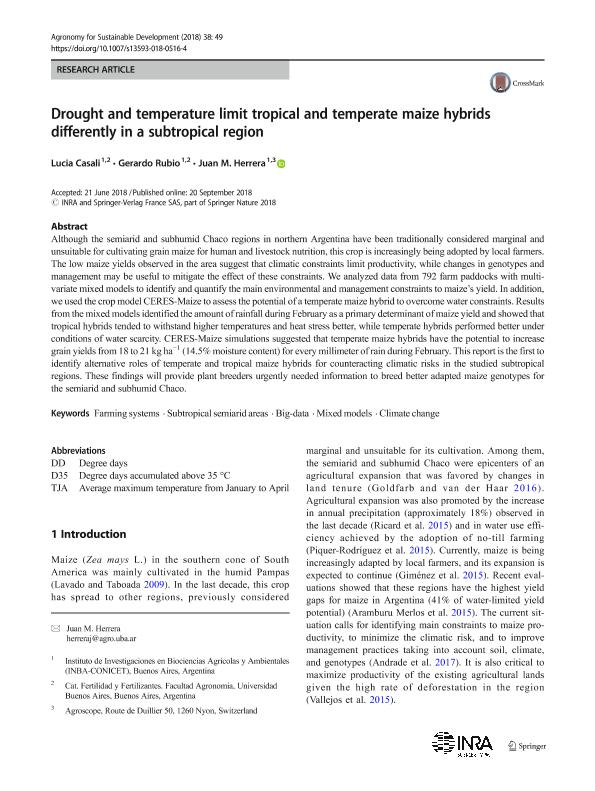Artículo
Drought and temperature limit tropical and temperate maize hybrids differently in a subtropical region
Fecha de publicación:
10/2018
Editorial:
EDP Sciences
Revista:
Agronomy For Sustainable Development
ISSN:
1774-0746
Idioma:
Inglés
Tipo de recurso:
Artículo publicado
Clasificación temática:
Resumen
Although the semiarid and subhumid Chaco regions in northern Argentina have been traditionally considered marginal and unsuitable for cultivating grain maize for human and livestock nutrition, this crop is increasingly being adopted by local farmers. The low maize yields observed in the area suggest that climatic constraints limit productivity, while changes in genotypes and management may be useful to mitigate the effect of these constraints. We analyzed data from 792 farm paddocks with multivariate mixed models to identify and quantify the main environmental and management constraints to maize’s yield. In addition, we used the crop model CERES-Maize to assess the potential of a temperate maize hybrid to overcome water constraints. Results from the mixed models identified the amount of rainfall during February as a primary determinant of maize yield and showed that tropical hybrids tended to withstand higher temperatures and heat stress better, while temperate hybrids performed better under conditions of water scarcity. CERES-Maize simulations suggested that temperate maize hybrids have the potential to increase grain yields from 18 to 21 kg ha−1 (14.5% moisture content) for every millimeter of rain during February. This report is the first to identify alternative roles of temperate and tropical maize hybrids for counteracting climatic risks in the studied subtropical regions. These findings will provide plant breeders urgently needed information to breed better adapted maize genotypes for the semiarid and subhumid Chaco.
Archivos asociados
Licencia
Identificadores
Colecciones
Articulos(INBA)
Articulos de INST.DE INVEST. EN BIOCIENCIAS AGRICOLAS Y AMBIENTALES
Articulos de INST.DE INVEST. EN BIOCIENCIAS AGRICOLAS Y AMBIENTALES
Citación
Casali, Lucía; Rubio, Gerardo; Herrera, Juan Manuel; Drought and temperature limit tropical and temperate maize hybrids differently in a subtropical region; EDP Sciences; Agronomy For Sustainable Development; 38; 5; 10-2018; 38-49
Compartir
Altmétricas




